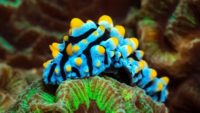By Melinda Christian The words “slug” and “festive display of color” don’t usually come to mind at the same time. Fun facts about nudibranchs or sea slugs. …read more Source: AIG Daily
If you were standing in a field of tomatoes, you might be surprised to know that the soil underneath your feet is teeming with electrical signals being sent among plants as described in a new research study.1 These results continue to expand the startling complexity of plant adaptation and point directly to an Omnipotent Creator who engineered it all. In 2013, a study was published showing that plants signaled each other… More… …read more Source: icr.org
By William Worraker The biblical and scientific arguments for a pre-Flood vapour canopy do not support the theory. …read more Source: AIG Daily
Recent research from the Okinawa Institute of Science and Technology Graduate University (OIST) continues to highlight how evolutionary theory influenced scientists to foolishly conclude that DNA in organisms not used to code for proteins (termed “non-coding” DNA) is useless “junk.” A press release highlighted an OIST scientist’s paper published in Nature Communications that identified a specific genomic reg… More… …read more Source: icr.org
Both amateur and professional stargazers have an opportunity to see a little more of God’s glory revealed in the heavens1 next week. The Perseid meteor shower is probably the best of all the annual meteor showers, and it is scheduled to put on a “peak performance” in the early morning hours of Monday through Wednesday, August 12-13.2 Meteor showers are caused by comets. When comets approach t… More… …read more Source: icr.org
Are scientists always objective? Do they always interpret the evidence with an open mind? Some time ago I experienced first-hand how a scientist’s beliefs affect the way he looks at the evidence. Whilst a geology student at university, I needed to identify a fossil. After consulting the Atlas of Invertebrate Macrofossils 1 I had tentatively identified it as a belemnite2 of the genus Hibolites. However, paleontology was not my specialty so I sought advice from an expert. …read more Source: creation.com
A new study published in Nature Ecology & Evolution has claimed that flowering plants, the most common type of plant on Earth, first appeared in small numbers in rocks of the Early Cretaceous. Fossils indicate that these plants became extremely abundant in rocks of the post-Cretaceous (or Cenozoic) after the dinosaurs disappeared in the rock record.1 However, creation scientists interpret these findings much differently. W… More… …read more Source: icr.org
New genetic evidence shows that humans may share DNA with super-archaic humans. …read more Source: creation.com
Did the physical mechanisms that operated during the Flood generate too much heat for Noah and the Ark to survive? …read more Source: creation.com
Vance Nelson’s latest book is impressive and like his previous works, contains a lot of original research accompanied with really beautiful pictures. A lot of time has gone into research and his photographic efforts. The book is written in an engaging and non-technical manner, and Vance took care to define his terms for lay readers. Summary: . …read more Source: creation.com
Evolutionary timeframes date the moon at about 4.5 billion years, with the lunar volcanism that produced the large, prominent and nearly circular, dark “seas” (or maria, as they are called) starting soon after that. The volcanism is mooted to have ended about three billion years ago. But researchers studying recent images of the far side of the moon, taken from the Japanese SELENE (Kaguya) lunar satellite, report dark “seas” of volcanic rock they say are “only” 2.5 billion years old, “much younger” than formerly presumed.1,2 That’s because there are fewer craters (blasted by meteors) on the smooth dark surfaces than [More]
In America, the month of July is accompanied by fireworks, even in the heavens.1 However, July is also a time when certain glow-in-the-dark animals—creatures of the sky and sea—shine forth their own “night lights.”2 Two such examples are noted here: lightning bugs in the air, and jellyfish in the sea. Both of these animals are bioluminescent. These creatures produce biochemical oxidatio… More… …read more Source: icr.org
The latter days of July are very busy for many pollinators.1 These include birds, bees, butterflies, moths, beetles, flies, bats, and more.1-3 Pollination is essential to a healthy planet. Humans, wildlife, and agriculture benefit enormously from the supposedly simple practice of airborne animals transferring pollen from one flowering plant to another.1,2 More… …read more Source: icr.org
Pagan and philosophical cosmogonies, and the major reinterpretations of Genesis 1 they have led to-gap theory, progressive creation, and theistic evolution-violate Genesis’ teaching about Creation, Rest and providence. …read more Source: creation.com
Dog genetics present a huge problem for evolution. Despite many centuries of breeding producing many varieties, from Chihuahuas to Great Danes, dogs are still dogs. …read more Source: creation.com
Recent research on the flying behavior of Alaskan alcids shows how Earth has two kinds of fluid-filled “oceans”, the liquid ocean of sea-water and the gaseous “ocean” of air.1-3 (Alcids are auk-like birds, such as murres, guillemots, and puffins.) The study reveals that these birds, from the Alcidae family which includes puffins, murres and their relatives, produ… More… …read more Source: icr.org
Most people might be surprised to learn that the human genome has not been fully sequenced. Gaps still remain that have not yet been bridged because of the nature of the DNA sequence coupled with past limitations on DNA sequencing technology. Nevertheless, a study has just been published using new and improved technologies that have allowed for the first complete sequence of a human chromosome.1 Sequencing the complete h… More… …read more Source: icr.org
For centuries, mercury has been used in thermometers for reading our body temperatures, but now we measure mercury levels to see if seafood is safe to eat.1-4 If you are hungry for fish, maybe trout would be a good choice.1 Nearly half of all gamefish in freshwater lakes, streams and rivers in the Chesapeake Bay watershed may be unsafe to eat because of high levels of mercury… More… …read more Source: icr.org
By Dr. Danny R. Faulkner Greek philosopher Heraclitus was one of the first promoters of an eternal universe, which found its way into Christian theology. The Bible tells a different story. …read more Source: AIG Daily
Did the 1918 Spanish Flu virus really go extinct, as genetic entropy predicted? …read more Source: creation.com
Beluga whales don’t select their friends according to what Darwinists would expect, a new Florida Atlantic University study shows.1,2 The research findings are taken from ten Arctic beluga whale ranges, including Alaska’s Yakutat Bay, Cook Inlet, Norton Sound, Canada’s Husky Lakes, Russia’s Gulf of Anadyr, and a small population by Norway’s Svalbard.2 More… …read more Source: icr.org
This month (July 2020), multiple astronomical objects highlight God’s glory displayed in the heavens.1 For the next two weeks, all five planets visible to the naked eye—Mercury, Venus, Mars, Jupiter, and Saturn—appear shortly before dawn for observers in the continental United States.2 However, Mercury, Jupiter, and Saturn are all low on the horizon at that time, so an unobstructed view of th… More… …read more Source: icr.org
A recent science news video shows barium-marked fluoroscopy of a ghost crab’s gut teeth in action. The video reveals how that species of crab can control friction of its gastric mill teeth (i.e., teeth inside its digestive gut) in order to communicatively project growling noises.1 Gut teeth are well-known as components in crab digestive systems, since crabs (like lobsters and crayfish) have no teeth in their mouths. … More… …read more Source: icr.org
The United Nation’s Intergovernmental Panel on Climate Change (IPCC) has recently claimed that agriculture is a major producer of greenhouse gases and should be considered a climate “villain.” However, the calculations that formed the basis of these claims completely neglected the fact that crop plants scrub the atmosphere of carbon dioxide on a massive scale, and thus help lower greenhouse gasses. This flawed global warming res… More… …read more Source: icr.org
The Salt Range of Pakistan has yielded some very interesting fossils-that according to evolution should not have been found! …read more Source: creation.com
By Dr. Nathaniel T. Jeanson Repeated misrepresentations of creationist views protect the legal basis for excluding creationism from the classroom. …read more Source: AIG Daily
By Dr. David Menton How the fossil record, evolutionary assumptions, artistic license, and anatomical differences do NOT confirm common ancestry between humans and apes. …read more Source: AIG Daily



















![God On the Mountain [Live] God On the Mountain [Live]](http://img.youtube.com/vi/J_mw33Fql9I/0.jpg)


























